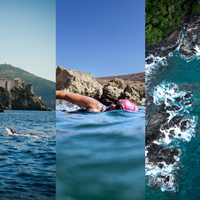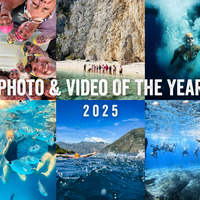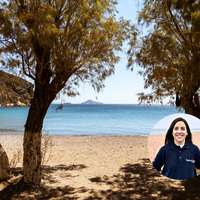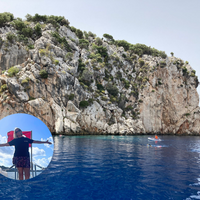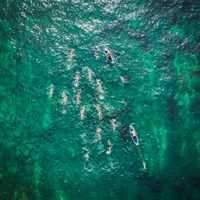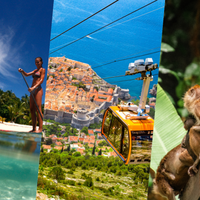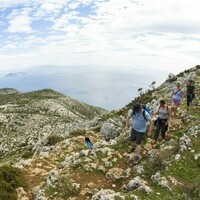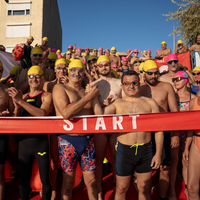If the lure of the water and the golden beaches isn’t enough to get you to the Galápagos, then maybe I can convince you with the insane wildlife it has to offer. With and abundance of land and sea creatures the Galápagos is a never ending treat for us nature lovers.
Galapagos Fur Seal
Let’s start with the Galápagos fur seal, maybe one of the cutest animal’s the Galápagos Islands has to offer..... Seriously Google image Galápagos fur seal pups; page upon page of cuteness. These seals are the smallest of the Otariids (also known as ‘Eared seal’) family. They have a grayish brown fur coat, with males reaching up to 64 kilos (141lbs) and the females up to 28kg (61lbs). It is reported that they spend on average 70% of their time on land; meaning that whilst swimming the islands coastlines, you will likely see one of them basking in the sunshine. Most other seal species have 50:50 spilt between land and water. The fur seal has been declining in population since the 19th century. Thousands of these seals were killed in the 1800’s by poachers, due to a high demand for their fur. In 1959, which Ecuador declaring the Galápagos as a national park, no major poaching has occurred, meaning that the population of this species has remained stable since. Even with this they are still on the endangered list, but population is growing, and they are getting ever closer to being off this list.
Marine Iguana
Another animal that gets to experience the delights of land and sea is the now famous (thank to BBC’s Planet Earth 2) is the Marine iguana. Marie iguana’s feed almost exclusively on algae. Large males dive to find this food source, while females and smaller males feed during low tide in the intertidal zone. They mainly live in colonies on rocky shores where they warm after visiting the relatively cold water or intertidal zone, but can also be seen in marshes, mangrove and beaches. Marine iguana’s currently find themselves on the vulnerable list by the IUCN. It is estimated that as many as 2’800 iguana’s can be found per kilometre on some shorelines; this is about 4’500 per mile. Although unintentional, human beings pose one of the most serious threats to this species. The Marine iguana has evolved over time in an isolated environment and lacks immunity to many pathogens. As a result, the iguanas are at higher risk of contracting infections, contributing to their threatened status.
The Galapagos Penguin
Of course I couldn’t write this blog post without mentioning the Galápagos most famous bird....The Galápagos Penguin. With an average size of 49cm (19in) long and reaching 2.5kilos (5.5lbs) they are the second smallest species of penguin after the Little Penguin. Galápagos penguins have a black head with a white border running from behind the eye, around the black ear-coverts and chin, to join on the throat. They have black-grey upperparts and whitish under-parts, with two black bands across the breast, the lower band extending down the flanks to the thigh. Juveniles differ in having a wholly dark head, greyer on side and chin, and no breast-band. Being so small the Galápagos Penguin has many predators on both land and sea – snacks, rice rats, Galápagos hawks fur seals and sea lions; just to name a few. Being the true romantic that they are, the Galápagos Penguin mates for life; the mating and breeding season are seen between May and January. With nests usually being made 50m of the shore line, it is defiantly something to look out for when sailing the coastline. These penguins are currently sitting on the endangered list, with a population size recorded of 1’500 individuals. The population underwent an alarming decline in the 80s of over 70%, but is recovering slowly.
Bottlenose Dolphins
Everyone loves a Dolphin and being able to see one in the wild is a true delight. Bottlenose dolphins are known to make an appearance in the waters of the Galapagos, usually jumping and swimming alongside crossing boats. Most Dolphin pops ranging from around 10-30 members; however pops of nearly 1000 have been reported in the past! Their diets mainly consists of forage fish, most of the time they will work as a team to harvest the fish; but it is also know for them to hunt individually. Dolphins search for prey primarily using echolocation, which is similar to sonar. They emit clicking sounds and listen for the return echos to determine the location and shape of nearby items, including potential prey. Bottlenose dolphins also use sound for communication, including squeaks and whistles, as well as sounds emitted through body movements, such as leaping from the water and slapping their tails on the water surface. Some of the reports that I have read suggest that the intelligence of these animals is the same as the intelligence of a 7 year old child... I find this absolutely incredible!
Green Sea Turtle
Last; but by no means least...we have the Green sea turtle, my favourite marine animal. This sea turtle's dorsoventrally flattened body is covered by a large, teardrop-shaped carapace; it has a pair of large, paddle-like flippers and is usually lightly coloured. Unlike other members of its family such as the hawksbill sea turtle, this turtle is mostly herbivorous; with the adults usually inhabiting shallow lagoons, feeding mostly of different types of sea-grass. Like many turtles the Green sea turtle migrate long distances between feeding grounds and hatching beaches. There are many islands known worldwide as Turtle Island due to these turtles nesting on their beaches. Females crawl out on beaches, dig nests and lay eggs during the night. Later, hatchlings emerge and scramble into the water. Those that reach maturity may live to 80 years in the wild. Currently placed on the endangered list by both the IUCN and CITES, they are under protection from exploitation in most countries. Meaning that it is illegal to collect, harm, or kill them. Sea turtles spend almost all their lives submerged, but must breathe air for the oxygen needed to meet the demands of vigorous activity. With a single explosive exhalation and rapid inhalation, sea turtles can quickly replace the air in their lungs. During routine activity, green and loggerhead turtles dive for about four to five minutes, and surface to breathe for one to three seconds. Turtles can rest or sleep underwater for several hours at a time, during the night while sleeping and to protect themselves from potential predators, the adults wedge themselves under rocks below the surface and under ledges in reefs and coastal rocks. Many green sea turtles have been observed in returning to the same sleeping location night after night. These creatures are defiantly something to look out for when swimming the blue waters of the Galápagos.
With there being endless amount of marine, land and flight animals in the Galápagos, you will never be bored of it wildlife. From the 5 that I have mentioned above to the Sea lion, American flamingo, King angelfish and the Lava lizard to name a few; you are sure to be spoilt from the moment you arrive!

